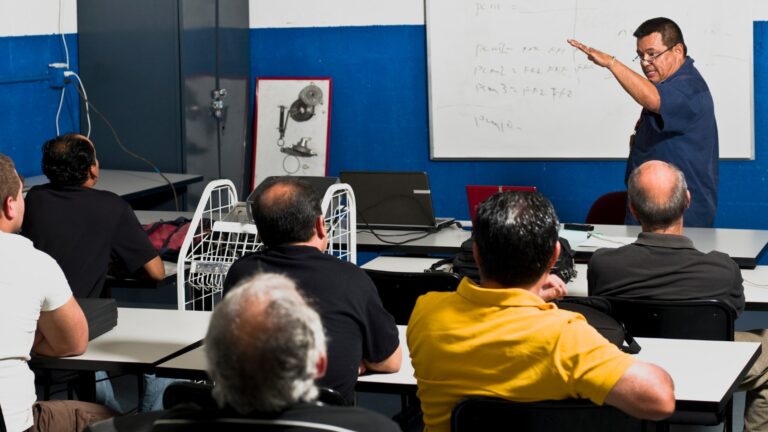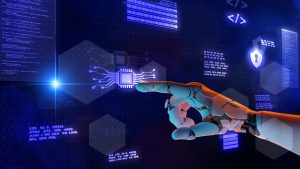A training centre is handling thousands of educational and coaching operations daily. It will be difficult and complex to manage all the work varying from assigning trainers and trainees, scheduling training sessions, handling admissions, bursary management, etc. That is where you need cutting-edge technology to organise training centre missions.
In this article, we’ll explore how the Training Management System or TMS can work like a sophisticated weapon to help training centres run smoothly and efficiently. We will learn about the unique benefits of TMS and how it could make learning easier for students as well as instructors in any training facility.
What is a 'Training Management System'?

It is an automated version of routine tasks in training organisation administration. It includes unique features that assist with expedited procedures such as online registration, course management, and monitoring and reporting. It is a gateway for arranging training in a centralised system that does not have any loops.
The fundamental goal of the TMS is to improve the delivery of training courses and training programs. TMS handles everything from enrolling courses to administering trainees, tracking performance, reporting assessment results, and skill gap insights.
Why Do Training Centers Require TMS?

Attendance Management
It is critical to track and manage student attendance efficiently in order to evaluate engagement, ensure compliance with attendance rules, and assess student progress. TMS streamlines and automates attendance tracking, decreasing human administrative chores and mistakes. Training facilities can employ TMS to conveniently collect and retrieve real-time attendance data, identify at-risk students, and give prompt assistance.
Also, the system allows instructors and administrators to create detailed attendance statistics, enabling for data-driven decision-making and performance evaluation. Training centres improve their operational efficiency and focus on providing a great learning experience for students by adopting TMS for attendance management.
Library Management
A well-equipped and well-organised library is critical for providing students with appropriate learning tools and materials. TMS simplifies library management by allowing for the classification, monitoring, and maintenance of a large database of books, e-books, and other educational resources. Students can quickly search for and borrow resources through TMS, while professors can propose required readings for specific courses.
The technology simplifies the lending process by sending overdue item notifications and allowing easy returns. TMS enables training facilities to build a knowledge-rich atmosphere, cultivate a culture of continuous learning, and provide students with access to a wide store of material.
Calendar Management
A well-managed calendar ensures that courses, classes, and activities run smoothly. A unified system helps to streamline the process by offering a consolidated platform for scheduling and updating training activities. Instructors can easily organise their teaching sessions in order to minimise scheduling issues. A clean and planned schedule helps students manage their study time more successfully.
It also supports real-time updates, ensuring that everyone is aware of any modifications or additions to the schedule. Training centres could streamline their operations, increase resource usage, and deliver an organised learning experience by implementing calendar management into their TMS, thereby promoting a healthy educational environment for all stakeholders.
Examination Management
TMS plays an essential role in the proper organisation and administration of examinations. The technology simplifies the whole examination process, from test production through grading and result processing. Online tests could be designed and administered by instructors, assuring secure and consistent evaluation. Grading is automated using TMS, saving time and eliminating mistakes.
It gives learners as well as teachers real-time access to findings, promoting openness and accountability. The system also provides data-driven examination performance analysis, allowing training institutions to discover areas for development and refine their teaching methodologies. Training centres offer fair and effective assessments by employing TMS for examination management, adding to the overall effectiveness and legitimacy of their educational programs.
Human Resource Management
This simplifies the difficult process of human resource management, from recruiting to performance review. It offers a single database for employee profiles, allowing for more effective personnel tracking and record-keeping. It makes instructor scheduling and allocation easier, resulting in better resource usage. In addition, the system automates payroll and attendance administration, reducing administrative expenses.
The system also provides professional development tools, allowing trainers and employees to get ongoing training. Training centres improve labour productivity, establish a healthy work environment, and eventually raise the quality of instruction given by combining human resource management into the system. It becomes a powerful strategy in the development of a successful and long-term training institution.
Admissions Requirements
This can help to streamline the admissions process by offering a centralised platform for managing and tracking admission requirements. Prospective students could simply obtain and submit required documentation via the system, making the application process simpler. It automates document verification and clearance, speeding up the admission decision-making process.
It also delivers real-time admission status updates, guaranteeing prompt communication with applicants. By utilising the latter for admission criteria, training facilities improve productivity, decrease administrative delays, and give ambitious students a seamless and transparent experience. It becomes an indispensable instrument for recruiting and accepting qualified individuals and building a successful learning environment.
Top 6 Benefits of TMS for All Training Centres

The Development of a Centralised Platform
The system unifies all areas of training management into a single system, simplifying operations and increasing efficiency. TMS facilitates simple access and seamless communication among instructors, administrators, and students by centralising student data, course information, timetables, and other key features.
This unified solution reduces the need for numerous distinct systems, lowering complexity and administrative expense. It enables training facilities to better manage their resources, track progress, and make data-driven choices. As an outcome, training facilities can enhance their procedures, deliver better learning experiences, and build a cohesive and productive training environment.
Tracking Capabilities and Skills
Latter enables training facilities to develop thorough skill profiles for each student, identifying their strengths, shortcomings, and areas for progress. Trainers can make use of this monitoring feature to evaluate individual progress, create individualised learning routes, and offer focused feedback. TMS allows for the evaluation of skill improvement over time, allowing training facilities to analyse the success of their programs and make required changes.
TMS tracking improves data-driven decision-making by allowing training facilities to identify high-performing students, spot future talent, and support those who might want further assistance. In the end, this characteristic assists training facilities in encouraging students’ continual growth and development.
Flexible and Effective
This allows training centres to adjust to and accommodate a wide range of learning requirements and preferences. The system enables instructors and administrators to create tailored learning experiences for students with its user-friendly interface and configurable features. The technology automates administrative processes including course development, enrollment, and scheduling, saving time and money.
This also enables students and instructors to communicate and collaborate in real-time, providing a dynamic and engaging learning environment. TMS improves the whole learning process by providing flexibility and efficiency, ensuring that training facilities can meet the ever-changing demands of modern education while also providing a meaningful and impactful experience for all stakeholders involved.
Collaboration without Location Restrictions
This serves as a digital bridge between students, trainers, and administrators, allowing for continuous contact and engagement independent of physical location. It fosters a feeling of community among distant students by facilitating real-time involvement through virtual classrooms, video conferencing, and online collaboration tools.
Students from various places can receive the same high-quality learning, and instructors can instruct without regard for distance. TMS breaks through geographical borders, allowing varied skills and experiences to join together in a coherent and collaborative learning environment. This feature expands training facilities’ worldwide reach and effect, guaranteeing equal access to information and skill development.
Quick Data Access
When a TMS is implemented, it gives administrators, trainers, and students real-time access to critical data and information. Users can obtain detailed records of student progress, course registration, attendance, and assessment results with only a few clicks. This real-time data access enables instructors to make informed choices about course modifications and individualised training.
Administrators can immediately review performance indicators and find areas for improvement. Students are able to keep track of their progress and stay up to date on their educational journey. The flexibility of the TMS to give data on-demand improves efficiency, transparency, and communication inside the training facility, leading to a more efficient and well-informed learning experience for everybody involved.
Cost-Cutting Measures
Training facilities could decrease the need to acquire and administer several platforms for diverse jobs by implementing a complete TMS, which can be costly and time-consuming. Latter is an all-in-one system that integrates critical operations like course management, enrollment, scheduling, attendance monitoring, and evaluation into a single platform.
This unification streamlines processes, lowers administrative expenses, and improves resource allocation. Also, TMS automates repeated procedures, saving teachers and administrators time and effort. Its cost-effectiveness enables training institutions to allocate more dollars to improving the learning experience and providing better training programs for its students.
Diving into Touch with the Depths of Technology for Training Centre Operations

Since you have read the whole article you know that to make sure that your training centre runs smoothly, you can not stay away from technology. TMS will manage all the work from handling students’ concerns, trainer allocation, and scheduling coaching sessions to administrative work, etc. through an automated system which will lead to less human error. However, you need to keep in mind that not every system is suitable for every training centre. You have to do thorough research before purchasing your best suit.






